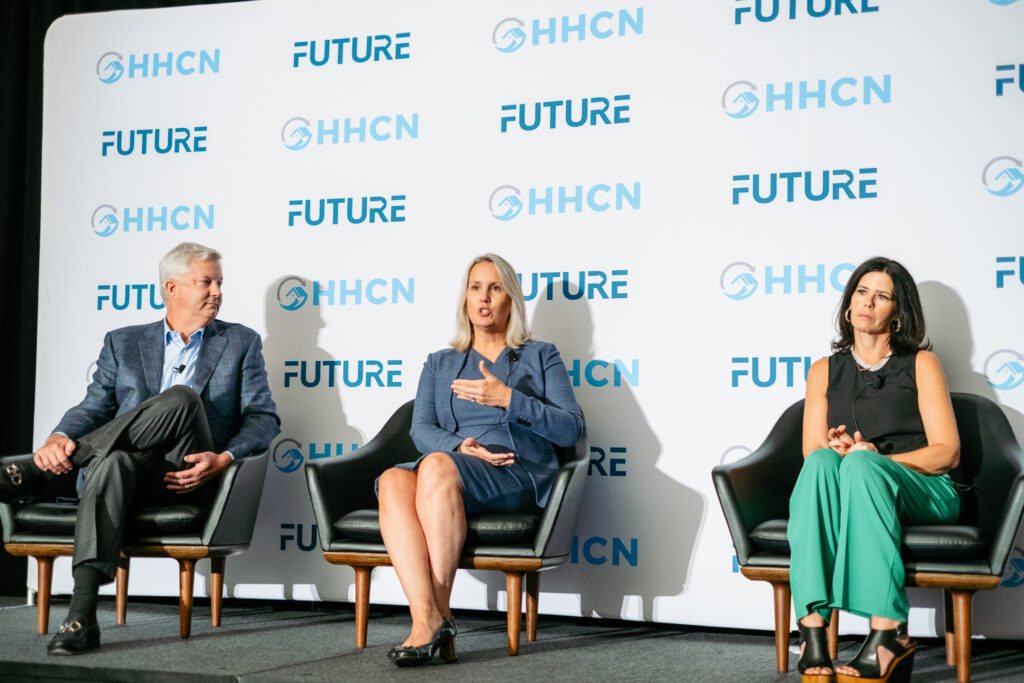As more home health providers participate in value-based care arrangements, leaders are learning what works, and what falls flat.
Enhabit Inc. (NYSE: EHAB) has been active in the value-based care space. The company has a small – but growing – number of value-based contracts on the Medicare Advantage (MA) side, as well as Accountable Care Organization (ACO) partnerships.
“Typically these look like upside potential based on quality metrics that both parties agree to, and we try to pick those quality metrics that are going to lower the total cost of care of patients,” Debra Konjanovski, senior vice president of payor innovation at Enhabit, said last month during a panel discussion at Home Health Care News’ FUTURE conference. “If we perform, then we have an opportunity to have some shared savings in that.”
Dallas-based Enhabit has 256 home health locations and 112 hospice locations across 34 states.
For the past few years, payer innovation has been a major component of Enhabit’s overall strategy.
At Bayada Home Health Care, value-based care is another tool that allows the organization to deliver quality care, according to Sue Chapman Moss, managing director of payer and provider contracting and strategy at the company.
“There’s a tendency towards price suppression in our category, and so value-based care is a way to differentiate, and to be able to share the performance that we’re already creating for our patients in their homes,” Moss said during the discussion.
Bayada provides home health, home care and hospice services in 23 states, as well as in Canada, Germany, India, Ireland, New Zealand, South Korea and the U.K.
Currently, Bayada has value-based arrangement partnerships with payers, ACOs and health systems.
“We’re working with partners … that are willing to make an investment in our caregivers,” Moss said. “The contracting structure is probably the least interesting factoid of our value-based care. It’s how we’re spending the dollars, and investing in our workforce, that we’re most pleased with.”
Moss believes that not diving into value-based care would be a missed opportunity for Bayada.
“If you believe in your care model, what you’re doing in the home is creating value,” she said. “If you’re not working with your payers to secure a portion of that value, and you’re just taking fee-for-service rates, all of that value is dropping 100% to the bottom line of the payer, or the risk bearing provider. We view it as part and parcel to securing better value and being able to hire caregivers and invest in great training.”
Key metrics and navigating challenges
Though it varies depending on the payer, there are some key metrics that home-based care providers should be ready to present when trying to establish value-based care arrangements.
“If you’ve met one payer, you’ve met one payer,” Integrated Home Care Services CEO Chris Bradbury said during the discussion. “Even within the payer, depending upon the line of business, whether it’s [MA], managed Medicaid or the commercial line, the ranking of the priorities differ. [However], there are some things that cut across all of them. Timely access to quality of care is super important, no matter who you’re talking to within the payer, whether it’s the network folks, the clinical folks, the finance folks or the line of business leaders for [MA], manage Medicaid or commercial.”
Integrated Home Care Services is a driver of value-based care in the home. The company partners with health plans, providers and other risk-bearing provider organizations.
Bradbury noted that providers should also be prepared to present patient experience metrics.
“With the changes in star ratings, I know our health plan clients that participate in [MA] are far more attuned to the patient experience, and how what you do can either positively or negatively impact their brand,” he said. “It can have a material impact on their financials and their growth.”
Konjanovski pointed out that providers sometimes face the challenge of finding the right person to talk to within the organization that it is trying to establish a value-based arrangement with.
“At times, it’s hard to find the right person in the organization that you need to talk to that can actually make the decision, and then once the decision is done and it’s on paper, actually executing it is a very long process,” she said.
It’s important for providers to recognize when an organization isn’t ready to fully commit to entering a value-based arrangement, according to Moss.
“Not all payers are ready,” she said. “If they’re struggling to pay claims and focused on audits and utilization management, that does not signal an organization that’s ready for your team to invest a lot of time and energy into a value-based arrangement.”
Ultimately, it’s best for providers to enter arrangements with organizations that want to establish a long-term partnership.
“[Find] payers who are willing to make a multi-year commitment,” Moss said. “These are not easy, one-year deals, and so you need to find partners that are willing to put in the time and the energy. Value-based arrangements take some time to get right and to learn together. If you have an adversarial negotiation, sometimes that doesn’t necessarily lend itself to a collaborative relationship at the end, so you always need to keep that in mind as you’re going through the process.”
Companies featured in this article:
BAYADA, Bayada Home Health Care, Enhabit Inc., Integrated Home Care Services




